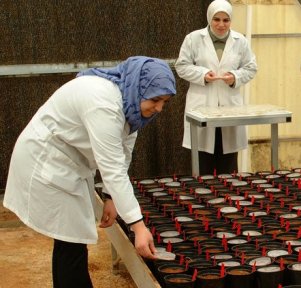Viability of cultivated barley and wild relatives genetic resources
Contributors to this page: ICARDA, Syria (Ahmed Amri, Bilal Humeid, Kenneth Street, Natalya Rukhkyan, Jan Konopka, Siham Asaad, Adnan Omran and Fida Alô).
|
Contents: |
Laboratory methods
Describes the various recommended options, to test the viability and quality of barley seeds. The percentage of germination of the stored seeds of the accessions determines when regeneration of the accessions should take place and if the accession can be distributed to the users.
Type of test
- Standard viability test, following the ISTA method (this one is more accurate, but more seeds are required and hence should be applied when there are enough seeds).
-
Sequential viability test, following the Bioversity International method (this one is less accurate, but requires fewer seeds and hence should be applied in the case of limited number of seeds - See Bioversity's genebank manual No 8).
- This test should be undertaken twice for accuracy.
- If the results are less than the critical value, an additional test should be done.
Number of seeds and replicates
- Standard viability test - 100 seeds and 4 replications (ISTA method).
- Sequential viability test - 10 seeds and 4 replications (Bioversity International method).
Pre-treatment
- Sterilize the seeds using 0.5% solution of sodium hypochlorite for 10 minutes (to avoid any fungi infections).
Media
- Petri dishes, filter papers and tap water.
Temperature
- 20-25oC.
Light
- No specific requirements.
Duration of test
- 5-10 days (most of the seeds germinate within this period).
|
Transplanting germinated seeds to the plastic house (photo: ICARDA) |
Interpretation of results
Following ISTA (2003, 2005) and Association of Seed Analysts (AOSA), 2005:
- For each accession, consider the total number germinated in each replicate.
- Calculate the mean viability percentage of that accession from the results of all replicates.
- If it is above 90%, accept the test as valid. If the result is below 85% (75% for wild species) repeat the test. Calculate the mean viability percentage from the results of the two tests and use this as the overall test result.
- If the results are far below the germination standard, the accession should be sent to regeneration.
- Germination is complete when the seedling can be judged as normal according to specific criteria.
Monitoring intervals
Describes the recommended intervals for different storage conditions.
- After five years of the initial storage, a random sub-sample from stored accessions should be subjected to a new germination test (preferred sequential test) to ensure a high quality of seeds during storage and to meet international standards.
- The results should be compared with the figures from an initial germination test.
- If the results match, the monitoring interval should be expanded.
- If a decline is observed, a larger random seed sample should be re-tested along with checking the storage facilities to avoid any improper conditions and leakages.
Recording information during viability testing
On petri dishes
- Accession number and replication number.
On data sheets and database
- Taxonomic name.
- Number of replications.
- Date started.
- Date ended.
- Temperature.
- Number of seeds (seedlings) germinated in each category (normal, abnormal, non-germinated) (ISTA).
- Germination percentage (counted on normal seedlings only) (seedlings are judged as normal according to specific criteria (ISTA, 2003, 2005; Association of Seed Analysts [AOSA], 2005).
Describes the recommended monitoring methods to assure minimum viability and quantity of seeds in storage.
Methods
- A computerized stock control system should be developed to monitor the quality and quantity of seed accessions in cold store.
To check the quantity
- Flags should be used to show that accessions are available for distribution.
- (L) Low stock: accession is available for distribution but multiplication should be planned.
- (S) Low number of seeds: no distribution should be allowed; sample should be multiplied. Distribution is permitted after multiplication.
To check the viability
- Random samples should be selected for viability testing. The results should be compared with previous viability test results.
- When viability is below the critical value the accession should be planned for regeneration.
- If the current viability is close to critical value, the date for the next test should be set for the following year; if viability is well above the critical value, the date of the next test should be set for five years after the current date.
- In the case of a significant decrease in viability, the genebank facilities should be checked for damage, leakage problems, etc.
Monitoring frequency
Lists the minimum quantity and minimum viability of seeds below which they need to be regenerated.
Critical quantity
- For both cultivated and wild relatives: 1000 seeds (to keep the integrity of the population samples).
Critical germination level
- Cultivated barley: 85%.
- Barley wild relative: 75%.
- Or 10% less than the average value of fresh seeds.
Recording information during routine monitoring
The following information should be recorded for each monitoring step:
- Accession number.
- Date of viability test (update database).
- Germination percentage (update database).
- Date of next test (one year if it is close to critical value; five years when it is above 90%).
- Regeneration flag: (Y – must go for regeneration; N – no need for regeneration).
References and further reading
AOSA (Association of Official Seed Analysts). 2005. Page 113 in: Rules for Testing Seeds (Capashew Ed.), 4-0, 4-11. Las Cruces, New Mexico, U.S.A.
FAO/IPGRI. 1994. Genebank standards. Food and Agriculture Organization of the United Nations, Rome and International Plant Genetic Resources Institute, Rome. Available in English, Spanish, French and Arabic.
ISTA. 2003. International rules for seed testing. International Seed Testing Association, Bassersdorf, Switzerland.
ISTA. 2005. International rules for seed testing. International Seed Testing Association, Bassersdorf, Switzerland.
Comments
- No comments found






Leave your comments
Post comment as a guest